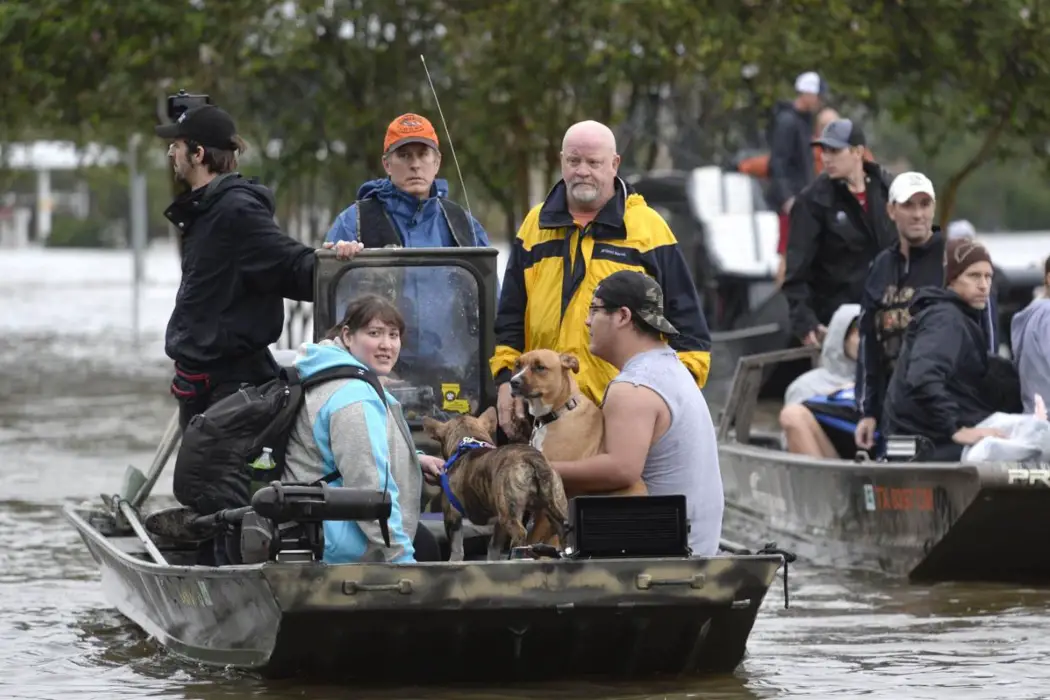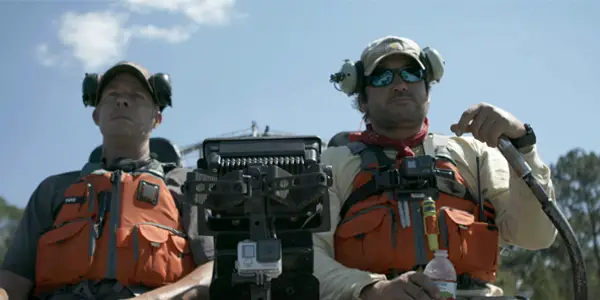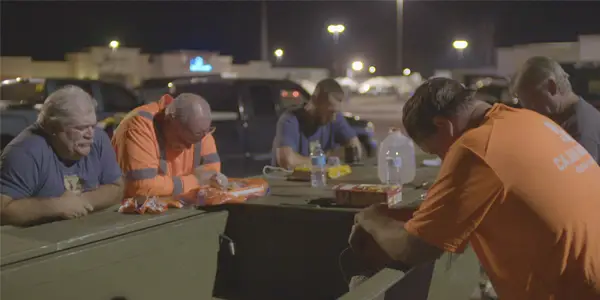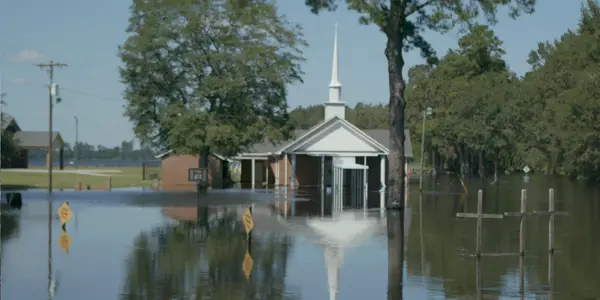CAJUN NAVY: The Heroes We Deserve

I'm a film journalist and independent filmmaker who fell in…
Formed in response to Hurricane Katrina, the Cajun Navy became a movement where many boat-owners would voluntarily rescue civilians and animals that have been trapped in cities devastated by hurricane-induced floods and destruction. The cause is an open invitation to people from all walks of life, irrespective of class, creed and race, but it isn’t an institution by any means; no one takes part in it because they have to, nor do they do it with the expectation of getting a medal. These volunteers even spend their own money on gas and supplies and never complain about it (but they do welcome outside donations).
In Cajun Navy, a Discovery Channel documentary, we find ourselves caught smack in the middle of a biblical disaster in the shape of Hurricane Florence (which occurred in September 2018), where we follow a group of Cajun corps volunteers and get a taste of the challenges and dangers that they are up against. Cutting between different hurricanes over the years, the film demonstrates the various degrees of complications that accompany the disasters, and hearing tales of dangerous situations are no less effective than the captured footage.
While it isn’t necessarily a cinematic film, it still boasts layers of drama, insight and intrigue, with the filmmakers treating their subject with the upmost ambition, and framing it as a humanist tale of inspiration. Ultimately, the film has a great sense of urgency, and tries to demonstrate what people could do when they put their heads together without the need to go through unnecessary logistics or wait for permission from higher authorities to do the right thing. It also makes it clear that whether you are a millionaire or a member of the working class, one disaster can make you both reach out for the same life jacket.
The Motivations
The Cajun Navy prides itself on being predominately made up of men and women from a blue-collar background (some of them being craw fishermen), but are also known to have brought in doctors. None of the volunteers seem to accept the notion that they could be heroes (despite the fact that some of them are war veterans) but they are fully aware that the Cajun Navy represents something far more important than any one individual.

The Navy members that the documentary chooses to centre on, are framed as decent, humble beings, but are not necessarily the cliched, clean-cut “good samaritan” types. Some admit to not being in control of their own demons, and others open up about overcoming their violent and unstable histories.
Faith, religion, second chances and the search for redemption form the backbone that motivates these people to take up this cause. It is through examining the weight of what others have lost, that their own individual baggage dwindles into insignificance, and they learn to put aside (what they deem to be) selfish desires in the hopes of saving those who are in dire need of help.
Structural Problems
At some point it becomes apparent that getting a glimpse of the personal dramas that engulf the volunteers’ lives is to the detriment of the film, despite the fact that it warrants our empathy and investment. Nothing can shake off the heroism that defines the Cajun Navy, but it is almost undermined by the filmmakers’ insistence on trapping a television documentary within the framework of a Hollywood “Feel-good” formula.
The numerous references to how lucky everyone is to be alive despite the loss of assets, property and resources are a no-brainer when it comes to comforting victims of disasters, but with the manner in which the film is constructed and edited, it does come off more as an adaptation of a self-help book rather than a slice of life, and one wonders if anyone was ever instructed to say certain things for the sake of the camera. The various issues that cast a shadow over their lives seem to be resolved so quickly upon returning home (for example) that they come off as simplified and tacky. Thankfully, the film didn’t feel the need to feature Joe Cocker’s “Feelin’ Alright”.
However, this is merely a problem with the pacing and structure. With regards to the film’s overall themes, the backstories and personal plights seem to be components of larger ambitions.
Iconography through Disaster
The film never loses sight of what is important about these noble knights, and ultimately shines when it simply lets the captured footage show us what’s important and remarkable about the Cajun Navy through their actions, rather than being on the nose and spelling things out.
Assessing Hurricane Florence before it transpires, the Navy try to collect as much data as possible before making long drives to try and reach the Lifepoint Church in Wilmington, North Carolina, where they will rest up and plan their strategies for the following day. It’s a race against time, and it’s a testament to their talents for improvisation and practical problem-solving that they manage to succeed as much as they do.
The footage is highly effective in exhibiting the dangerous atmosphere that will greet the volunteers and the citizens of North Carolina, with the anger and darkness of the night skies setting the stage for hurricane clouds spiraling into a dooming presence, electric cables being struck by lightening, and, eventually, the unforgiving floods pouring in. What follows are the complications as a result of landfall and secondary flooding, and ordinary suburbs are transformed into sunken environments and watery graves. Houses and vehicles suffer immense damage, and those that remain standing may endure the misfortune of being consumed by the bacteria-infested water.

Many are able to remain calm as they stand outside their house ready to be transported out of the affected areas in the Navy’s boats. Others, however, are frightened; not just for losing their lives, but for losing their assets. Occasionally, the Navy will find the time to help someone recover their belongings from a flooded car, but the priority is always the safety of the victims.
Of course, not everyone can be found or rescued. The Navy will often find an “X” placed on the door of a house, signifying that the house has been thoroughly searched with no trace of life.
Animal safety is no less significant, which include dogs that are either drowning or stranded in isolated, broken structures, or an alpaca with too much water in its lungs, whereby many failed resuscitation attempts lead to a noble act of mercy to end its suffering. The feelings of angst remains with you throughout the film, and you never forget that all life is sacred, especially in times of disaster.
Some of the most horrifying scenes involve volunteers rescuing the elderly from nursing homes, especially those who are immobilized and incapacitated. Inside the homes, rising water threatens those who are confined to their beds or on wheelchairs, and those that are paralyzed or in a coma are carried out carefully, with their faces covered. As if that weren’t enough of a challenge, the Navy would be challenged by the nursing home directors with corporate laws and regulations that seem extremely redundant in a disastrous situation.
The situation of the United States as depicted in the film only fuels the anger of some of the Navy members and drives them deeper into their work. The American Dream is a lost cause, because the working-class and the less privileged who helped build the country are being ignored, neglected and often left to be destitute. Naive people are sold houses they can barely afford by devious landowners, with the lie that their new property has never been flooded before. It’s hard to blame them for any anti-establishment sentiments they may have, especially when it boils down to the fact that they simply don’t want to see anyone get hurt, starve or be homeless.
It is the frustration with corporate America, who are doing little to rectify the problematic class system and the injustices suffered by amputees, blue collar workers, the disabled and military veterans, that makes us thankful that people like those in the Cajun Navy exist.
Some victims are too afraid to leave their homes, which requires certain tactics to persuade them that leaving is the right thing to do. One volunteer suggests that they use a permanent marker to write down their social security numbers on their arms so that identifying their corpses will be easier. This encourages the victims to go with the Navy.
There is a rather touching scene captured in the documentary, where one volunteer tries to persuade an elderly woman sitting in the front porch of her home to safely evacuate it, lest she be affected by the rising water. While appreciate over the efforts and the humanity behind the volunteer, she remarks that she has been through much hardship in her life and that she doesn’t want to be told what to do or to abandon her property. Knowing that you can’t physically remove someone who doesn’t want to go, the volunteer respects her wishes. It is in that scene where the essence of the Cajun Navy is realised, where they know that fixing everything is not a realistic goal, but that they will never stop trying their hardest.
As the volunteers drive around with their boats latched onto their vehicles, looking for areas where they can be of service, it’s easy to draw comparisons to firefighters rushing into blazing buildings, soldiers in the chaos of war or astronauts venturing into the unexplored depths of space. Interestingly enough, the gritty, nocturnal imagery that follows them on their boats as they navigate the murky terrain in the dark of the night, not only invokes Apocalypse Now or southern gothic westerns, but also presents them as a real-life contrast to comic-book superheroes and figures from Greek Mythology.

It isn’t so much about the obvious displays of bravery and selflessness that conjures up these similarities, but more to do with the fear and uncertainty that plagues them. Like the victims they search for, the shadow of death looms large over their shoulders, and, based on the individual plights brought up in the film, they are fully aware of the threat of failure.
It is also the diplomatic, non-violent methods the Navy choose to take when fighting off the stubborn forces of authority, whether it be taking a detour to avoid the eyes of the National Guard patrolling the bridges (on the lookout for looters), or even in finding ways to bring supplies to survivors despite police blocking off various routes. It is in those times that we can believe them to be superheroes, who don’t simply try to wreck an established system but rather try to negotiate some form of change, in order to give the less fortunate a chance for a better life.
It is all the more heartbreaking to see scenes where families return to their damaged homes, seeing the lives they built taken away by an unbiased Mother Nature. All the Navy can do is to encourage them to maintain hope and know that material things can always be replaced, but lives can’t.
Cajun Navy: Legacy
There is no doubt that this is an important documentary, highlighting the efforts of ordinary people who strive to make a difference, and encourage everyone else to do so. Their stories are practically begging for a cinematic documentary, where all sides can share their stories (including ignorant nursing home directors) and give us a portrait of 21st century United States. It is the disaster that brings together a country that is otherwise ravaged by inequality and racism, where people put aside their differences and work towards the greater good.
What did you think of the film? How would you handle those situations were you a Navy member? Let us know in the comments below!
The Cajun Navy was released on the Discovery Channel on July 23rd, 2019.
Does content like this matter to you?
Become a Member and support film journalism. Unlock access to all of Film Inquiry`s great articles. Join a community of like-minded readers who are passionate about cinema - get access to our private members Network, give back to independent filmmakers, and more.
I'm a film journalist and independent filmmaker who fell in love with cinema at a young age. I also love writing about comics, literature, podcasts, television and video games. I'm just as content watching a movie about a giant killer pig terrorising the Australian outback as I am with one that features a catholic priest in crisis.












